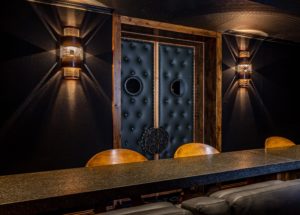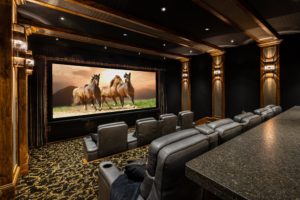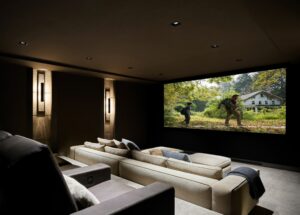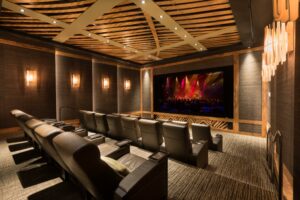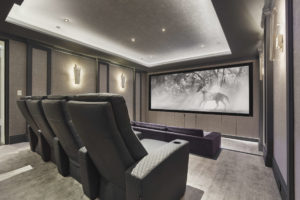Pursuit of Perfection: Passion, Performance and Standards of Excellence
The Luxury Private Cinema has arrived as de rigueur for those who value the finer things. More so now with the greater emphasis and value placed on the at-home experience. The personal movie, music, and media pursuits of many are being shared more intimately and more extraordinarily than ever before. But if you are considering a private cinema for yourself, how will you know when you are moving in the right direction and when you are being led astray? Home theater advice abounds but is not always good.
Discerning good advice is not a challenge unique to private cinema connoisseurs. The term connoisseur originated out of the necessity to objectively establish the value of artwork. Consistently accurate advice abounds in many fields, enabling those who find pleasure in art, horology, fine automobiles, antiquities, and other transcendent pursuits to invest confidently, knowing their objectives will be fulfilled, and their lifestyles elevated. Historically, however, private cinema advice has lacked objective standards of excellence. Why the disparity?
Home theater at its inception was a phenomenal success that attracted many to the industry. Some had experience, many did not. Like the California gold rush, home theater became the wild west of home entertainment. Manufacturers, installers, designers, and purveyors of all sorts scrambled to meet the demand and often did so with no real understanding of how to create quality private cinemas or even what good meant. There were no rules. Many ignored the criteria that did exist, and much trial-and-error was practiced in the field as professional research and development struggled to keep up with new technologies, systems and increasing demand. Some applied what was known at the time about audio, video, and small room acoustics and there were some very good results. A new trade organization was formed with CEDIA’s launch in 1989. The new organization soon realized that education and standards of excellence would be vital to the growing industry but efforts to establish standards labored under nagging trends of bad information, poor implementation and compromise.
This is not new in the business of audio relates Dr. Floyd Toole, AES Life Fellow, well known and respected acoustician (retired from a notable career at the National Research Council of Canada (NRCC) and Harman International) and author (Sound Reproduction 3rd Edition and numerous AES papers). “The mythology that has built up about certain brands and speaker designs and electronic algorithms and so on” Dr. Toole explains, “precious few if any of those are based on double-blind tests”. Floyd asserts that: “In double-blind listening tests, people show substantial agreement on what good sound is. They clearly prefer timbrally “neutral” reproduction: loudspeakers with very flat, very smooth on-axis response, that behave themselves off-axis.” Dr. Toole concludes, “We have known what the target behavior of a good loudspeaker is for a long time.” In the real world, variability in program material and varying bass response in listening rooms (roughly 30% of one’s overall sound quality evaluation) complicate common forms of subjective evaluations. Floyd and his team at the NRCC and Harman International spent decades performing research and generously providing that research to the industry. Standards based on real science are largely ignored by an industry that has had no incentive to hold itself accountable. Until now.
The interest and emphasis on high-quality in-home lifestyle experiences have the attention of CEDIA. “We need to mature as a profession” Walt Zerbe, CEDIA Senior Director of Technology & Standards states. “There has been a lot of wild, wild west and lack of standards, lack of engineering and true design.” Like the connoisseurs advising on the provenance of renaissance masters, a core of modern-day cinema connoisseurs, led by Zerbe and Peter Aylett, CEDIA RP10 Standards Committee Chair, have spearheaded an initiative to raise professional standards. “It’s radical for the industry, a peer-reviewed industry consensus,” explains Aylett “putting objective criteria to defined levels of performance.” The initiative is being led by CEDIA in collaboration with the CTA. “Both are ANSI accredited standards development organizations, which is a very important part of this story.” Explains Zerbe, “providing legitimacy through the ANSI consensus-driven process that requires a mix of interested parties.” Indeed, the workgroups consist of engineers, designers, integrators, manufacturers, consultants, and other confreres. ‘
Asked what these residential entertainment space standards will do for enthusiasts, Aylett says, “standards ensure consistency, CEDIA RP10 will provide a consistency of experience that is extraordinary.” The initiative also signals a change of perspective and approach to one that is less about selling a product and more about identifying and meeting real-world personal objectives. As Peter describes it, “It’s about moving away from product toward human-centricity.” Walt adds, “our end goal is about having people make good, informed decisions.” The process includes the rigorous discovery of the objectives for each person served, performing engineering and design using accurate data made readily available by vendors to meet objectively verifiable performance standards that correlate with those individual goals. Walt sums it up by saying, “we want to specify standards for the design, installation, and integration of technology for people to support their lifestyles. That would be [the actions of] a mature industry. That would be the direction we want to go.”
It sounds good! But, like the phrase from Field of Dreams “If you build it, he will come,” it may be wishful thinking. Without motivation, who will comply? Will an industry that is already busy change anything? It is a matter of motive. An industry driven by the bottom line will trade performance for passable and excellence for expedience, providing just what is required to turn a profit. What if our raison d’ê·tre however is to grow an industry that is recognized for the extraordinary? An industry known for providing elevating experiences and that ascribes to values of artistry, excellence, and integrity. Would such an industry attract an appreciative audience? Or is it the reverse? Will an audience that demands excellence, extraordinary experiences, and artistry, and requires a level of professional expertise and standards of performance, drive the industry to recreate itself and do what it takes to satisfy such a clientele?
Some have chosen not to wait. Many manufacturers, engineers, designers, and integrators; producers of audio, video, acoustics, and aesthetics, have chosen excellence over compromise. George Lucas famously stated, “Sound is half the experience in seeing a film.” Keshav Nelavai, Lead Acoustical Engineer for Paradise Theater, states, “Loudspeaker performance is one of the most critical metrics for us when engineering a private cinema room and having accurate, complete and usable data enables us to perform our work with confidence.” Nelavai adds, “Lack of such data leaves us guessing, which is unacceptable.” When asked how many manufacturers provide such necessary information, Keshav confides, “It’s a surprisingly short list!”
The Cinema Connoisseur polled that short list and the results are telling. An even shorter list of seven responded. All respondents were aware of the standards and criteria but only three of seven were actively involved in the CEDIA initiative. When questioned further about the importance of objective standards, all considered them important with four of seven considering them very important. In stark contrast, respondents overwhelmingly agreed the industry seemed to be in denial and clientele kept in the dark. Six felt the industry would ignore standards and that will make it more difficult to get the word out to the market. One respondent went so far as to say, “80% of customers will trust the advice of consultants who may not have the right answers.” Who has these answers?
One audio company that responded is HARMAN Luxury Audio. Jim Garrett, Sr. Director, Product Strategy & Planning explains, “We are very much based on a foundation of science.” Harman has a legacy of research in developing products themselves and is also known for sharing research with the industry. Jim goes on to say, “A lot of the research and science from Harman have become the industry standards. Look at the work of Floyd Toole, Sean Olive and Todd Welti. The papers they have written led to many of the [existing] standards.” When asked about industry awareness and compliance, however, Jim laments, “I don’t know that there is awareness. It’s obvious when you listen to different systems and see everybody’s taking their own approach.”
“I think we have to work hard as an industry to support these standards and best practices.” Kevin Kent, Global Product Line Manager for Harman Luxury Audio states. Kevin goes on to say, “we’re likely to struggle to get traction and awareness with the integrators. I question whether it [standards] could be effectively explained to the customer.” When asked how Harman would assure compliance with standards and performance criteria, Jim explains how the CEDIA initiative lines up well with Harman’s system approach and certification. “We are revamping the certification program for JBL Synthesis immersive audio systems. Based on using our products the way they were intended to be used, designed together in systems, properly installed, and calibrated to our target response curve, you get the certification.” Harman will offer two levels of certification – Certified and Certified Elite.
Meyer Sound also responded. Like Harman, Meyer Sound has professional, cinema, studio and post-production divisions as well as a rich legacy of research and development. This breadth of experience provides Meyer with a valuable perspective on professional standards and how they are applied. When asked what standards and performance criteria are important for luxury private cinema, Jay Wyatt, Meyer Sound Program Manager, Cinema and Residential, replied, “SMPTE ST202 and ST222 loosely have some application in private home cinema, but not explicitly. I’m looking forward to how the CEDIA committee develops a standard for [private cinema].” Meyer Sound is one of the aforementioned proactive companies, having unilaterally developed a test signal, M-Noise, that was adopted by the Audio Engineering Society (AES, the organization universally admired for objective and reliable audio information and standards). (See inset AES75-2022, “AES Standard for Acoustics: Measuring loudspeaker maximum linear sound levels using noise.)
When asked about the private cinema industry’s response to standards, Jay responds, “It is one thing to create a standard, and it is another to get the standard widely adopted and followed.” Adding, “I think it will be a bigger challenge to get standards followed in private cinema than in post-production applications. At the end of the day, the consumer is likely not as versed in standard bodies [AES, SMPTE] as a re-recording engineer or media systems engineer would be for a studio.” Asked if the professional industry would influence the private cinema Jay replies, “I would like to think so. A movie soundtrack needs to translate from post-production to the theater and down to the consumer. So, ideally, all three industries should have similar goals if they want to preserve creative intent.” An ideal exemplified by Meyer equipped Production Studio (Fantasy Film Center), Meyer equipped Cinema (ArcLight) and Meyer equipped Private Cinemas (Mountain Paradise and Vintage Tropical Theater).
Geoffrey Heinzel, Partner & Director International Sales & Marketing, when asked about industry standards and the CEDIA initiative, shares, “We at ASCENDO are honored to be invited to participate in the CTA standards committee.” Further emphasizing the need for change in the private cinema industry he states, “very few in the private cinema industry are aware and adhere to standards, as it’s a rare manufacturer that gives them correct data to work with. Instead, marketing-driven data is published.” ASCENDO, a technology company followed their deep musical heritage and decades of research to found Ascendo Immersive Audio (AIA) on the principle that concentric, point source loudspeakers are superior for immersive audio applications. Geoffrey asserts that private cinema owners should expect to be, “completely transported by the performance.” An experience that requires loudspeakers capable of remarkable clarity and precision. Geoffrey points to the amazing ability of our auditory system (Floyd Toole’s “two ears and a brain”) to distinguish even minute errors in timing and timbre. Errors that tell the listener it isn’t real. Geoffrey calls AIA sound “True to life.” Adding, “isn’t that what we all try to achieve?” AIA backs the accuracy of its audio rendering with data. “Cornerstones for us [are] speaker linearity, driver signal to noise ratio, lowest distortion, wide [symmetric] dispersion, high resolution. To achieve this and verify the results, we invested in the latest measurement technologies and software. All our products and measurements are then verified by a third-party lab.” Engineers designing theaters make good use of this information. Keshav, from Paradise Theater, says, “Data like this is a rarity in our industry! Having all this data allows us to design rooms with the utmost confidence that the room will perform as predicted.”
Geoffrey sees the need to get the word out. Without an informed clientele, he says “It’s, easy to have products just specified and installed in private cinemas without any consideration for the data behind them and the performance.” Geoffrey adds, “To the best of my knowledge, very few in the private cinema industry are aware and adhere to standards, as it’s a rare manufacturer that gives them correct data to work with. Instead, marketing-driven data is published.” Even with that, ASCENDO has taken a position of leadership, action and optimism. Says Geoffrey, “Our pursuit of perfection can be seen not only in [full range] speaker designs, being the first and only company that offers infrasonic subwoofer systems capable of reproducing the lowest frequencies recorded, for serious groundbreaking private cinemas.”
Wisdom Audio’s mission is the finest expression of audio to the delight of its clientele. Though admirable, that alone is not unique. All the manufacturers who responded and are included in this article share similar values. Unique is their dedication to the development of alternative technologies and configurations of loudspeakers to achieve that customer fulfillment. These technologies are, planar magnetic transducers (PMD), regenerative transmission line (RTL) subwoofers and line source (LS) loudspeakers. According to Wisdom Audio, these technologies offer advantages in the accuracy of detail, bass performance and room interactions. Though unique this ironically highlights a similarity. A commitment to engineering, measurements, and standards. Luc Guillaume, Managing Director describes how performance verification is vital for non-traditional technologies, “Measurements are vital to loudspeaker design and standards are there to be exceeded. [Wisdom performs] systematic on-axis and off-axis measurements with multiple iterations, then critical listening and measuring of every design in multiple applications.” Necessary, Luc asserts for, “confidence that every design will perform as intended in the final test, the client’s room.”
“That’s my movie, that’s how it is supposed to sound!”
Andrew DeCristofaro, Supervising Sound Editor, upon hearing Unbroken in the Wisdom Audio factory demonstration theater
What about the industry’s awareness of and compliance with standards and performance criteria? Ron Rouse, VP of Sales reports, “between SMPTE, CEDIA, AES, Dolby and opinions on the internet, it’s confusing and inconsistent. Nothing is impossible but the whole industry needs to come together.” Ron goes on to describe the impact on a manufacturer like Wisdom, “It means extra time spent with dealers, reviewing CAD drawings and proposed designs to assure accurate implementation of systems in rooms.”
Luc’s solution is education and cultural change saying, “education is a better understanding of acoustics and culture is changing how systems are designed,” clarifying, “specifying merely to fit a budget has little chance of success.” Ron agrees, “Our time would be better spent helping clients appreciate the benefits of great sound. When that happens, budget is not an issue!” Luc adds, “We have expanded our engineering team and are giving our loudspeaker lab a complete makeover to provide all the data theater designers need and we educate our dealers with academies and individually to ensure high performance reaches the client.” All that is left is to share the joy of great sound with those clients!
Editors note: See Dreams Do Come True for example. SC
“Listen.” Instructs Giles Smith, CEO of TPI Sound, “then measure.” TPI Sound manufactures professional audio equipment, including loudspeakers, amplifiers, audio processors, and accessories for studio, high-output, and theater markets. Giles continues to say, “we take measurements at the end of our engineering and design process. Our chief engineer and loudspeaker designer, over 50 years designing loudspeakers, is adamant, saying “there is no substitute for listening to a loudspeaker.” To be clear, Giles is in favor of standards and criteria clarifying, “The idea of standards is good for a myriad of reasons such as comparing like models between manufacturers, yielding accurate data for acoustic modeling, etc.” It is the misuse of standards that is a concern. “Misapplied and misunderstood data used as marketing tools to falsely qualify products which in fact don’t meet relevant performance criteria.” It is a conundrum of caveat emptor, where the nascent cinema enthusiast will need to verify the advice given by the advisors. The solution? “An easily accessible impartial and cost-effective way to test and certify products. This will level the playing field and increase the quality of the product in the market.” Giles suggests. TPI would like to see that come to pass as the cost of performance verification is heavy. “The cost of this across our full range is vast. We test every product we manufacture to a Pass-Fail envelope established during our research phase. Every result is stored for each loudspeaker’s serial number. We have invested heavily in our R&D facilities and have a sizeable in-house anechoic chamber, with test equipment from all the major brands.”
Giles and TPI’s engineers are of the opinion there are indeed things that can be heard but not measured. “I can always hear a TPI loudspeaker.” He asserts, adding, “Our engineer spends a lot of time audibly verifying phase coherence because he knows depending on the software alone can lead to poor results.” There are other elements of the TPI product that defy measurement as well. “if you look at the basic data, frequency plots and things like that, it tells a 10th of the story. For instance, a loudspeaker is a motor trying to release energy into the space. How efficiently it is released affects how the listener hears it. TPI proprietary cones do this very efficiently resulting in a visceral quality of the sound even at low sound levels. It is remarkable and incomparable. You don’t want to miss that experience!” Giles compares that to another ineffable experience. “Standards get you to basecamp. That’s good because you will never reach the summit if you start at the trailhead. But listening is the pinnacle of the audio experience!”
Peter Lyngdorf founded Lyngdorf and Steinway Lyngdorf with a passion for superb sound and a dedication to engineering and research. “It started out with a big investment from Peter in R & D,” recalls Thomas Birkelund, CEO, “we didn’t have anything to sell. We just started out developing. It comes from an opinion that you need to do things right, and you need to have the knowledge in house. We continue to invest in R and D.” Thomas was sure to point out that even he, as CEO, is an engineer. Further explaining, “We see ourselves as a technology company. With our technology, we can control everything in the signal chain, not only the speaker.” How does this relate to the standards being developed by CEDIA and the final customer experience? Claus Glaesner, CEO/HTP Consultant, Steinway Lyngdorf, US, points out “Standards and measurements are generally a good thing and let installers as well as customers rely on a certain quality, ensure certain functions and product compatibility, and allow [them] to compare products.” Claus, clarifies this last statement by saying, “On the other hand, not everything that defines quality can be put in numbers and specs, but certainly there needs to be a database to find all relevant information.”
How can a customer, or for that matter a consultant sort through it all? “It starts inside the product. There are many performance criteria, for example deep within the audio signal path of an amplifier or sound processor, which our engineers know about, yet [are] unknown to the private consumer or even installer. It’s our ambition to meet or even improve on such performance criteria to create great products. Same with the mechanical-acoustical construction inside a loudspeaker.” For an appreciation of what it all means, Claus points to experience saying, “when it comes to sound performance and sound quality, there’s not much that can replace the listening experience, and [the customer should] make objective-subjective decisions based on that.” Claus sets a lofty goal saying, “[Anyone who] has visited a studio [knows]: Movies, music, games are created with stunning perfection. Dolby Atmos, DTS:X, IMAX, AURO all spend an unimaginable amount of time and effort in creating superb soundtracks and sound effects, all recorded and mixed in the highest audio resolution.” Claus sets the mark by saying, “We would like to see private cinemas matching the amazing quality that is already created in the filming and mixing studios.”
PRO Audio Technology Founder and President, L. Paul Hales is committed to standards, criteria and engineering in the development and manufacturing of loudspeakers. He is also committed to demonstrating the results in a profound way. Paul backs up both convictions with substantial investment to spectacular effect.
“I absolutely believe in data; I have a strong belief in research and engineering in the development of products. I rely on measurements and the push from CEDIA, IEC and others to standardize loudspeaker measurements is a great thing.” Hales states, further clarifying, “It gives consumers a way to [objectively evaluate] the performance of a loudspeaker.” Paul then contends, “I don’t know how many manufacturers are actually going to do it, but we are.” The monetary investment alone to take measurements in compliance with accepted standards is steep. Requiring either a stiff initial investment, significant ongoing costs, or both, depending on how measurements are taken. PRO invested in the latest technology. “I invested in the Klippel Near Field Scanner (link to video and inset piece on the Klippel), a six-figure purchase.” Paul continues, “One of the things that the Klippel will give me after a complete scan, is it will calculate the CEA 2034 results (see inset on loudspeaker measurements). You can learn very quickly whether the speaker is well-engineered or not.” Paul considers the Klippel results superior, with greater resolution and better low frequency extension. But what does all this mean to the cinema connoisseur?
“You have to share the wine!” Paul advises, comparing good sound to great wine. Stating that it isn’t reasonable to expect the public to educate themselves on what makes great cinema sound. “Many haven’t learned to appreciate sound yet because they haven’t had that experience where it changed for them.” Paul goes on to explain the rationale behind PRO’s other big investment and the beneficial and dramatic effect it has had on clientele. The PRO Audio Technology Experience Center features carefully engineered demonstration theaters where guests are treated to an unforgettable audio (and video) experience. Paul describes the program as a “formal program where we’re flying people in for a visceral and emotional demonstration that words alone cannot convey.” Paul claims the investment in the experience center as well as staging the demonstrations is worth it “because once a customer tastes the fine wine, they want that wine.”
Editors note: See Tale of Two Cinemas and Buffalo Run Cinema (this issue) for examples of luxury private cinemas with PRO systems. SC
For those of us in the private cinema industry, there is cause to celebrate but with a word of caution. We can celebrate an industry that is taking action to provide standards of excellence whereby professionals and enthusiasts alike can objectively evaluate quality. This is a significant step. But it is only the first. We must follow up on this first step!
1. Each of us on the professional side must hold ourselves accountable to the standards and our personal values and fulfillment. “Strive for perfection in everything. Take the best that exists and make it better. If it doesn’t exist, create it.” (Henry Rolls)
2. We must also help our colleagues be accountable. We are building this industry together and need to collectively aspire to a high-water mark of competency. Our industry will not deserve the admiration of a passionate community with weak links in the chain.
3. We must share the wine! Truly share it. Become cinema connoisseurs, and cinema sommeliers, and share the many elevating aspects of cinema. sound, music, cinematography, design, the art form, and the shared experiences that come with it. Open the doors to those we would serve, the cinema connoisseurs who will be the beneficiaries of the excellence we deliver. As an industry, we must share the wine!
For those considering a private cinema, there are only two steps.
1. Taste the wine. Insist on the good wine. Require your cinema sommelier to share what the distinguishing qualities of their vintage are and how they will satisfy and improve your personal palate. Done right, private cinema is an elevating experience that will always grow better with time!
2. Accept only a cinema experience that is true to yourself, your loved ones, and your life.
“The quality of a person’s life is in direct proportion to their commitment to excellence.”
Vince Lombardi
“The quality will remain when the price is forgotten.”
Henry Rolls
The Cinema Connoisseur is dedicated to furthering the awareness and advancing the experience of the private cinema to enhance the lives of those who admire the private cinema, the experience nonpareil.
